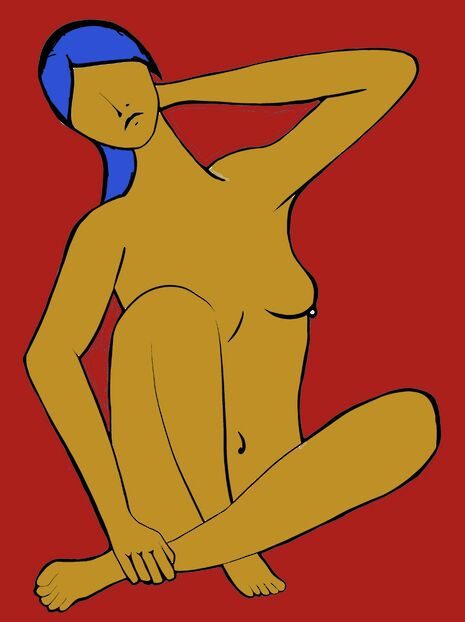Hiding my body in clothing
When suffering from body insecurities, clothes can become an enemy. However, Phoebe Cramer argues that for her they also became a tool for recovery

Content note: this article contains discussion of body dysmorphia, body image issues and eating disorders.
I used to have a pile of “My Favourite Clothes” stashed beneath my bed. The idea was for them to be out of sight, but I thought of them when dressing each morning. These clothes were my old staples. A pair of mom jeans from a mild 2016 hipster phase; a vintage top found in my grandmother’s memory box; some muted blue trousers with the right amount of fray. None were particular favourites or had any important impact of my style, but somehow they became my most important clothes.
It was because they no longer fitted. Or they did, but in a way that made me panic and pull them off again before my reflection sunk in. I loved those clothes, I loved the identity they represented and the memories attached. I did not love my body in them.
I started to think in terms of ‘me’ and, separately, ‘my body’. This sent my relationship with clothes reeling.
They became my target. Why get rid of them when I’ll look how I want to in them soon? Why waste such a useful tool of measurement? Of comparison, when I had photos of myself in those clothes that I loved?
The relationship between body image and style is as complex as it sounds. It is entwined with self-identity and gender, and amplified by the photographic, media-orientated lives we live. To engage with fashion and develop a style is only fun when we have a good relationship with our bodies.
Fashion should never be inaccessible. Style is for all body shapes and types: thin to fat, disabled or able-bodied. Putting on weight is not a bad thing. Clothes not fitting and sizes changing is natural. But when a person has body image issues, when the facts are irrelevant and the internal dislike overwhelming, fashion can feel like a draining stress.
When my body-image issues reached their worst, I detached my body from my identity. It sounds philosophical, but really just means that I started to think in terms of ‘me’ and, separately, ‘my body’. This sent my relationship with clothes reeling. I have always felt best wearing clothes that represent myself, but gradually, I grew to want my body to be excluded from that definition and identity.
When a person has body image issues, fashion can feel like a draining stress
I felt undeserving of the clothes I loved and- in my mind- used to look better in. It felt like they were mocking me, reminding me of what I used to look like and could look like if I only X or Y or Z.
I developed an aversion to seeing other people in my clothes. By ‘other people’ I mainly mean my friends: a borrowed dress, a jumper to keep off the chill. They looked infinitely better in them. It was my style, my fashion, my precious clothes, but the person wearing them actually looked good. Deserving in a way I felt I was not. Some items I was put off forever and since have left my wardrobe. Of course, I would be surprised, but happy, if any of those friends felt perfectly comfortable with their bodies at all times.
Never read an article like that. The aim of fashion is not to look the slimmest you possibly can.
Through all of this though, I learnt that fashion can be a genuine tool of recovery. I am not the first to announce that style can also make us feel really, really good about ourselves. For some, it may take a mental trigger, for some a physical. (For me - a green jumpsuit).
When I started to resent my clothes and how I looked in them, I had to restock my wardrobe. I googled ‘Best Cuts To Wear For Each Body-Type’ and followed that advice. I quickly learned, however, that certain types of fashion do not belong to certain types of people. Never read an article like that. The aim of fashion is not to look the slimmest you possibly can.
So then I was forced to branch out into styles I had never considered before. I tried new trousers and skirts and dresses and tops and everything in between. It was a gradual process, but I got bolder. Patterns and colours felt eye-catching in a good way again, as opposed to drawing attention to a body I wanted to hide.
The pile of “My Favourite Clothes” no longer lives under my bed. I gave them away without trying them again. Perhaps I would have liked the way I looked in them, perhaps they would have helped me to feel good about my body again. Perhaps they would have just dragged me back to a time of insecurity and doubt. To every person holding onto something that they hope to wear in the future ‘if they get brave enough’ or ‘when they lose that weight’, get rid of it. Style should never be restricting. It should evolve and develop along with ourselves – including our bodies.
 News / Cambridge academics stand out in King’s 2026 Honours List2 January 2026
News / Cambridge academics stand out in King’s 2026 Honours List2 January 2026 Interviews / You don’t need to peak at Cambridge, says Robin Harding31 December 2025
Interviews / You don’t need to peak at Cambridge, says Robin Harding31 December 2025 Comment / What happened to men at Cambridge?31 December 2025
Comment / What happened to men at Cambridge?31 December 2025 News / Varsity’s biggest stories of 202531 December 2025
News / Varsity’s biggest stories of 202531 December 2025 Features / “It’s a momentary expression of rage”: reforming democracy from Cambridge4 January 2026
Features / “It’s a momentary expression of rage”: reforming democracy from Cambridge4 January 2026










